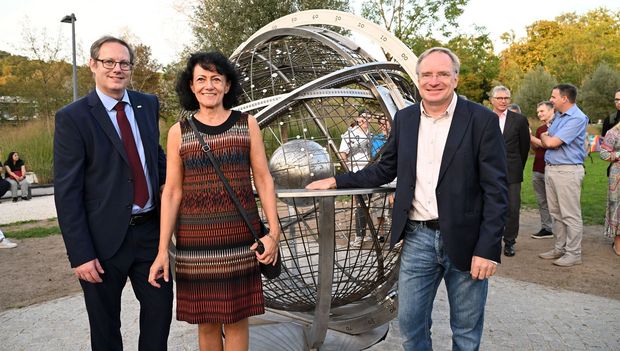Johannes Kepler (1571 - 1630) was many things: an astronomer, a physicist, a mathematician - and our university’s namesake.

To this day, Kepler’s work continues to intrigue and inspire countless researchers, including Austrian experimental physicist, Werner Riegler. In honor of Kepler, Riegler has constructed a 2.3-meter sundial which was placed at the JKU last week.
Riegler earned a degree in physics at the Vienna University of Technology and works at the Cern, where he played a role in creating the Large Hadron Collider (LHC). In addition, he made time for an unusual hobby: "Even when I was young, I always enjoyed creating and building sundials," remarked Werner Riegler. His pieces are on display at Solar City in Linz and in Grein along the Danube. He has now created his masterpiece: an astronomical sundial that keeps entirely in line with Kepler's legacy.
Riegler explained: "Up until 200 years ago, conventional sundials were the official way to keep time but they deviate from the uniform 'real' time by up to 16 minutes. The difference is caused by the Earth's axis tilt and the Earth's non-uniform motion around the sun. This motion is, in turn, defined by Kepler's Laws. I wanted to build a sundial representing these motions and deriving the exact time based on them." In addition to an accurate display of the time, the sundial features an incredible number of built-in details, such as a precisely reproduced star globe from Kepler's Rudolphine Tables star catalog and a globe featuring a world map from Kepler’s same work. This sundial also features aspects including the Platonic year of 25,500 years and the Earth’s perihelion rotation of a period of 20,500 years.
At the sundial’s unveiling, JKU Vice-Rector Alberta Bonanni remarked: "The creative energy behind the sundial is incredibly impressive, along with the technical skill behind the work. I want to do more than simply say thank you as this piece is incredibly inspiring, attesting to the researchers’ passion and creativity and, above all, demonstrating just how grateful we should be to our predecessors. Curious minds such as Kepler’s have laid the foundation on which our modern society, and all its accomplishments, have been built."
The stainless-steel sundial is on display on the lawn in front of the Kepler Hall at the JKU. In conclusion, Riegler held a presentation titled: "Eine Astronomische Sonnenuhr für die Johannes Kepler Universität Linz". He expressed one wish above all: "I just hope that people won't simply look at the sundial as an object, but that they will try to understand the details and imagine themselves in the point of view of the cosmos during Kepler's time".








